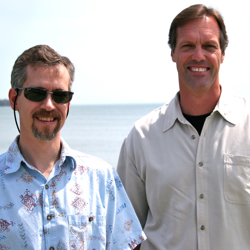Duffy and Lipcius speak at national ocean conference
Professors Emmett Duffy and Rom Lipcius of the Virginia Institute of Marine Science were invited participants in last week’s National Conference on Science, Policy, and the Environment in Washington, D.C.
The conference, Our Changing Oceans, was hosted by the National Council for Science and the Environment (NCSE) and brought together an unprecedented combination of top leaders in ocean science and policy from academia, government, and the environmental community. It provided a forum for addressing the many challenges facing marine resources, and focused on the policy and governance solutions needed to restore and protect ocean health worldwide.
During the 3-day event, more than 1,300 scientists, professionals, policy makers, and citizens developed a set of recommendations on how to advance ocean science and connect it to policy and decision-making. The Conference was divided into 8 themes, each with several breakout sessions and symposia.
 Duffy, Loretta and Lewis Glucksman Professor of Marine
Science at VIMS, was an invited speaker in the breakout session on Attaining an Operational Biodiversity
Observing Network: Transforming Recommendations to Action.
Duffy, Loretta and Lewis Glucksman Professor of Marine
Science at VIMS, was an invited speaker in the breakout session on Attaining an Operational Biodiversity
Observing Network: Transforming Recommendations to Action.
Lipcius was invited to speak in a symposium titled Beyond the Obituaries: Marine Ecosystem Success Stories.
Biodiversity Observing Network (BON)
Duffy and his fellow speakers—Heidi Sosik of the Woods Hole Oceanographic Institution and Jerry Miller of the White House Office of Science and Technology Policy—discussed how to advance the recent recommendations they developed with a federal interagency panel to create a “Biodiversity Observing Network” (BON) for the nation’s coastal, open-ocean, and Great Lakes ecosystems.
Duffy, who says that biodiversity is important to ocean health in the same way that a diversified portfolio is important to financial health, extends the analogy to the proposed network: “We now know that healthy and diverse marine life is critical to our own lives and security, and we can’t manage that relationship properly without knowing who is out there, where, and in what numbers. We need our finger on the pulse of marine biodiversity in the form of standardized processes and infrastructure for monitoring and tracking the diversity of organisms, species, and populations in U.S. waters.”
During their session, Duffy and the other participants discussed how a BON would help implement the President’s new National Ocean Policy, which federal entities should lead the BON effort, the means for establishing one or more “Biodiversity Observation Headquarters,” and methods for coordinating and standardizing biodiversity sampling.
The participants agreed that the accelerating loss of marine biodiversity brought on by global climate change, pollution, overfishing, ocean acidification, and invasive species make development of a biodiversity observing network a national priority, and note that recent advances in equipment, analysis techniques, and data management provide an opportune moment for seizing the initiative.
Marine Ecosystem Success Stories
Lipcius and his fellow speakers—Dr. Stephen Palumbi, Director of Stanford University’s Hopkins Marine Station; Dr. Kathryn Mengerink of the Environmental Law Institute; and David Helvarg, president of the Blue Frontier Campaign—presented case studies of how marine ecosystems have improved thanks to protection and active restoration, and described recent legal actions that make future successes more likely around the world.
Lipcius highlighted the recent up-surge of blue crabs in Chesapeake Bay and restoration of some of the Bay’s local native oyster populations, success stories that have grown out of decades of field and laboratory research by Lipcius and colleagues at VIMS and elsewhere.
Lipcius says these success stories “not only offer hope for the future of the Chesapeake Bay ecosystem, but serve as examples of a revolution in scientific restoration involving rigorous experimental and quantitative science, popular and political support, and courageous and bold management actions.”
Session chair Nancy Knowlton, Senior Scientist and Sant Chair in Marine Science at the Smithsonian's National Museum of Natural History, says "Rom's work is a perfect example of how science can be used to inform management actions for real success in marine restoration." It's important, she adds "to highlight our successes as well as our challenges, in order to bring continued inspiration to the ocean conservation movement."
Moving Forward
Peter Saundry, Executive Director of the National Council for Science and the Environment and official conference host, says the event “brought together a broad array of experts to develop real-world solutions to reducing the growing pressures facing the world’s oceans.” He adds “By harnessing these new ideas from a diverse set of stakeholders, the conference is poised to be a turning point for future ocean policy action.”
NCSE, a 501(c)(3) non-profit established in 1990, is dedicated to improving the scientific basis of environmental decision-making. NCSE specializes in programs that foster collaboration between and among the diverse institutions and individuals that create and use environmental knowledge, including research, education, environmental, and business organizations as well as governmental bodies at all levels.
The Virginia Institute of Marine Science, chartered in 1940, is among the largest marine research and education centers in the United States. VIMS has a three-part mission to conduct interdisciplinary research in coastal ocean and estuarine science, educate students and citizens, and provide advisory service to policy makers, industry, and the public. The School of Marine Science (SMS) at VIMS is the graduate school in marine science for the College of William & Mary.

